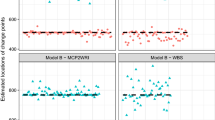Abstract
A class of nonstationary time series such as locally stationary time series can be approximately modeled by piecewise stationary autoregressive (PSAR) processes. But the number and locations of the piecewise autoregressive segments, as well as the number of nonzero coefficients in each autoregressive process, are unknown. In this paper, by connecting the multiple structural break detection with a variable selection problem for a linear model with a large number of regression coefficients, a novel and fast methodology utilizing modern penalized model selection is introduced for detecting multiple structural breaks in a PSAR process. It also simultaneously performs variable selection for each autoregressive model and hence the order selection. To further its performance, an algorithm is given, which remains very fast in computation. Numerical results from simulation and a real data example show that the algorithm has excellent empirical performance.
Similar content being viewed by others
References
Chen, J., Gupta, A.K.: Parametric Statistical Change Point Analysis. Birkháuser, Basel (2000)
Csörgő, M., Horváth, L.: Limit Theorems in Change-Point Analysis. Wiley, Chichester (1997)
Davis, R.A., Huang, D., Yao, Y.C.: Testing for a change in the parameter values and order of an autoregressive model. Ann. Stat. 23(1), 282–304 (1995)
Davis, R.A., Lee, T.C.M., Rodriguez-Yam, G.A.: Structural break estimation for nonstationary time series models. J. Am. Stat. Assoc. 101(473), 223–239 (2006)
Fan, J., Li, R.: Variable selection via nonconcave penalized likelihood and its oracle properties. J. Am. Stat. Assoc. 96(456), 1348–1360 (2001)
Perron, P.: Dealing with structural breaks. In: Patterson, K., Mills, T.C. (eds.) Palgrave Handbook of Econometrics, Econometric Theory, vol. 1, pp. 278–352. Palgrave Macmillan, Basingstoke (2006)
Takanami, T., Kitagawa, G.: Estimation of the arrival times of seismic waves by multivariate time series models. Ann. Inst. Stat. 43(3), 407–433 (1991)
Zhang, C.: Nearly unbiased variable selection under minimax concave penalty. Ann. Stat. 38(2), 894–942 (2010)
Author information
Authors and Affiliations
Corresponding author
Rights and permissions
About this article
Cite this article
Jin, B., Shi, X. & Wu, Y. A novel and fast methodology for simultaneous multiple structural break estimation and variable selection for nonstationary time series models. Stat Comput 23, 221–231 (2013). https://doi.org/10.1007/s11222-011-9304-6
Received:
Accepted:
Published:
Issue Date:
DOI: https://doi.org/10.1007/s11222-011-9304-6




